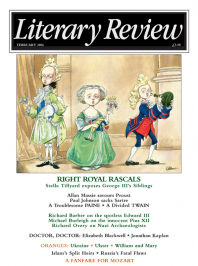Gillian Tindall
Rolling Back The Smog
City of Cities: The Birth of Modern London
By Stephen Inwood
Macmillan 538pp £25
What is this book and what is it not? It is, firstly, a wonderfully comprehensive reference volume, which will be invaluable to keep on hand for anyone needing to check up on the multifaceted phenomenon of London in the last two decades of the nineteenth century and the first two of the twentieth – roughly the period during which all four of my grandparents grew from infancy into middle life: this was the townscape that formed them, and whose assumptions they tried to pass on to the next generation. Stephen Inwood supplies a highly competent overview of the time when London was not only the world’s largest city and its banking centre but also the hub of a vast empire. His impressive range of facts is reliable, and his approach admirably sensible: he is quite right that, from today’s perspective, the popular view of ‘Victorian London’ is a shrunken and compressed one, as if Dickens’s undrained, ill-lit city of the 1840s, full of beggars and child sweeps, had remained much the same until the end of the century. The central thesis of his study is that London grew and changed enormously, both physically and in terms of social evolution, during the last quarter of Victoria’s reign and that the infrastructure was then already being laid down for the capital that was there by the 1920s.
But Inwood’s previous, equally useful and weighty tome (A History of London, 1998) has already covered this same period as part of its general scope. Enormous amounts of statistical and observational material are available to historians for these recent times, and my guess is that the author found himself with

Sign Up to our newsletter
Receive free articles, highlights from the archive, news, details of prizes, and much more.@Lit_Review
Follow Literary Review on Twitter
Twitter Feed
Russia’s recent efforts to destabilise the Baltic states have increased enthusiasm for the EU in these places. With Euroscepticism growing in countries like France and Germany, @owenmatth wonders whether Europe’s salvation will come from its periphery.
Owen Matthews - Sea of Troubles
Owen Matthews: Sea of Troubles - Baltic: The Future of Europe by Oliver Moody
literaryreview.co.uk
Many laptop workers will find Vincenzo Latronico’s PERFECTION sends shivers of uncomfortable recognition down their spine. I wrote about why for @Lit_Review
https://literaryreview.co.uk/hashtag-living
An insightful review by @DanielB89913888 of In Covid’s Wake (Macedo & Lee, @PrincetonUPress).
Paraphrasing: left-leaning authors critique the Covid response using right-wing arguments. A fascinating read.
via @Lit_Review